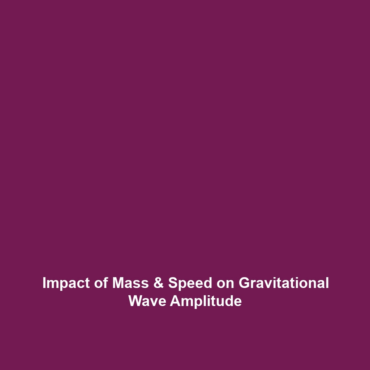How the Mass and Speed of Merging Objects Affect Wave Amplitude in Gravitational Waves
Introduction
The intersection of mass and speed of merging astronomical objects plays a crucial role in determining the amplitude of gravitational waves. These ripples in spacetime, first predicted by Einstein’s general theory of relativity, have opened a new window into the universe, allowing scientists to explore phenomena that were previously invisible. Understanding how these fundamental characteristics of merging bodies influence wave amplitude is essential for advancing our knowledge of gravitational wave astrophysics and unlocking secrets of the cosmos.
Key Concepts
Understanding Gravitational Waves
Gravitational waves are generated by the acceleration of massive objects, particularly during cataclysmic events such as black hole mergers or neutron star collisions. The key concepts include:
- Mass: Heavier objects exert more gravitational influence, leading to stronger distortions in spacetime.
- Speed: The rate at which these objects approach each other affects the frequency and amplitude of the resultant waves.
- Amplitude: Represents the strength of gravitational waves, which has direct implications for their detectability on Earth.
Relation Between Mass, Speed, and Wave Amplitude
The interplay between the mass of merging objects and their velocity greatly influences gravitational wave characteristics. For instance, a high-speed collision of a significant mass can produce waves with heightened amplitude, enhancing the likelihood of detection by observatories like LIGO and Virgo.
Applications and Real-World Uses
Understanding the mass and speed of merging objects and their effect on wave amplitude has far-reaching implications in gravitational wave research:
- Astronomy: Improving our understanding of cosmic events and the behavior of black holes.
- Cosmology: Offering insights into the expansion of the universe through the observation of wave amplitudes.
- Physics: Enhancing gravitational theories by providing empirical data on predictions involving wave production.
Current Challenges
Despite the advancements in detecting gravitational waves, several challenges persist in studying the relationship between mass, speed, and wave amplitude:
- Detection limitations: Current detectors may miss waves with lower amplitudes, leading to incomplete data.
- Data interpretation: Analyzing the complex data produced by gravitational wave events remains a significant hurdle.
- Modeling precision: Accurately modeling the dynamics of merging objects requires sophisticated simulation techniques.
Future Research and Innovations
Future research in this domain is set to revolutionize our understanding of gravitational waves:
- Next-generation observatories are being developed to enhance sensitivity and allow for detection of a broader spectrum of wave amplitudes.
- Advancements in computational capabilities will enable more accurate simulations of merging events.
- Interferometry techniques are evolving, promising improved measurement precision and insight into the properties of gravitational waves.
Conclusion
In conclusion, the mass and speed of merging objects significantly affect the amplitude of gravitational waves, impacting their detection and interpretation within the cosmos. As our observatories evolve and our theoretical frameworks improve, understanding these relationships will become increasingly vital in uncovering the mysteries of the universe. For further reading on gravitational wave discoveries and implications, explore our articles on black hole mergers and neutron star collisions.
